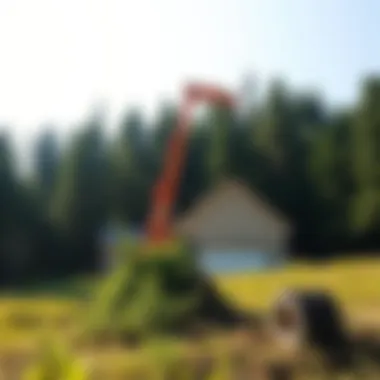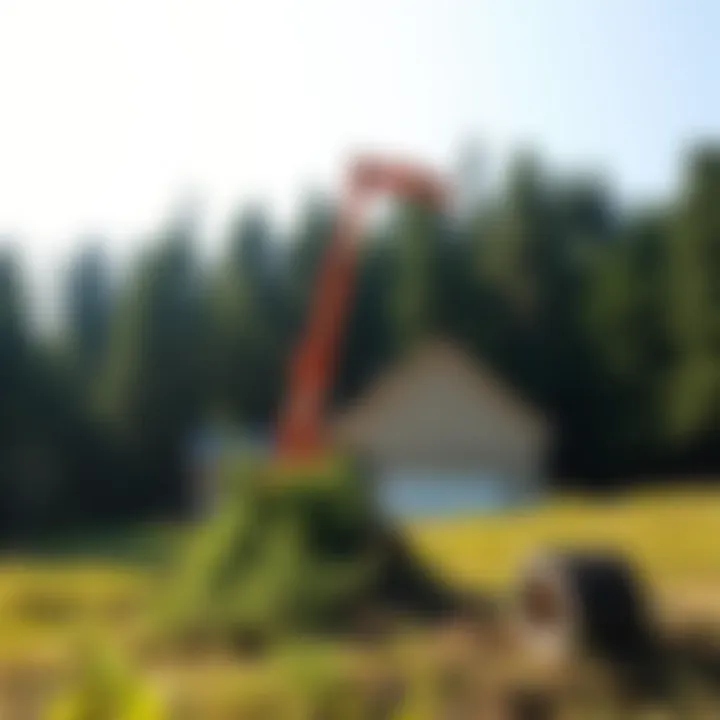Navigating Tree Removal: Legal and Practical Insights


Overview of Forestry Practices
When it boils down to tree cutting on your property, understanding the broader context of forestry practices is essential. Forestry isn't simply about chopping down trees; it's about managing wooded areas to maintain ecological balance while enhancing land utility.
Importance of Foresting
Forests are the lungs of our planet. They play a crucial role in carbon sequestration, which helps fight climate change. Additionally, forests provide habitats for countless species, contribute to local economy through timber production, and protect watershed areas from erosion. In short, forests are multifaceted resources that demand thoughtful stewardship. Keeping this in mind can guide people in their decisions regarding tree removal, and underscore the significance of maintaining forest health in the long run.
Types of Forestry Practices
There are various approaches to forestry, each with its own focus and methodology. Here are a few key types:
- Sustainable Forestry: This approach prioritizes long-term health and productivity of the forest. It seeks to balance the extraction of timber while preserving the ecosystem.
- Commercial Forestry: Here, the primary goal is profit through timber harvesting. This often involves clear-cutting or high-intensity practices which can lead to significant ecological change.
- Agroforestry: This combiness agricultural practices with forestry. It’s about integrating trees into farming areas to provide shade, improve soil, and produce additional crops.
- Community Forestry: Here, local communities manage forests, prioritizing both their needs and ecological sustainability. This practice is gaining traction as it encourages involvement and support from local populations.
Each of these practices has its merits and drawbacks, and understanding them is key for property owners contemplating tree removal. Trees fill many roles, from providing shade on a hot day to serving as barriers against wind and erosion. Therefore, property owners should be aware of how their cutting decisions might ripple through these established dynamics.
Best Practices for Sustainable Woodland Stewardship
When it comes to managing trees on your land, applying best practices is crucial to ensure that you’re acting in a responsible and informed manner. Not just for today, but for generations to come.
Principles of Sustainable Forestry
- Biodiversity: Maintaining a variety of species supports a more resilient ecosystem, which could protect against pests and diseases.
- Permanence: Trees should not be cut just for immediate benefit. Planning for long-term growth is essential to sustain forest resources.
- Resource Optimization: Efficient use of resources, including minimizing waste during cutting processes, ensures that precious materials are not squandered.
- Community Engagement: Involving local communities not only builds goodwill but also taps into valuable local knowledge about land management.
Techniques for Land Management
To maintain a healthy ecosystem and effectively manage woodland areas, property owners can adopt various techniques:
- Selective Cutting: Instead of clear-cutting, removing specific trees based on health and size can help sustain the overall ecosystem.
- Shelterwood Cutting: This method involves removing trees in phases, allowing younger trees to grow under the protection of larger, mature trees, thus ensuring a more natural regeneration process.
- Replanting and Conservation: After cutting, replanting new trees helps retain the ecological balance and speeds up recovery.
"It’s not just about cutting trees; it’s about understanding the intricate dance of ecosystems around us."
Innovative Techniques in Forestry
With advancements in technology and a growing understanding of ecological dynamics, the forestry sector is constantly evolving. Techniques once considered novel are now becoming standard practice.
Latest Technological Advancements
Drones, for instance, are now being used for forest mapping and monitoring tree health. These flying devices can provide aerial views that are invaluable for property assessments. Furthermore, software can analyze data and predict the best times for harvesting based on tree growth patterns.
Integrating Traditional Knowledge with Modern Science
Bridging the gap between time-honored methods and contemporary advancements can yield remarkable results. Indigenous practices often emphasize respect for natural cycles, and combining them with scientific approaches can enhance forestry practices. The wisdom passed down through generations can offer insights into maintaining biodiversity.
For further exploration, interested readers might visit websites like National Forest Service or Society of American Foresters for more comprehensive details on sustainable practices.
Understanding Property Rights and Responsibilities
When pondering whether to cut down trees on one's property, understanding property rights and responsibilities becomes paramount. It's not just about ownership; it's about navigating a complex web of legal obligations, community norms, and environmental ethics. This knowledge helps property owners grasp the full scope of their actions and ensures that decisions made are both lawful and considerate of the surrounding community and ecosystem.
Defining Ownership: What Does It Mean?
To say that someone owns a piece of land is to imply a variety of rights and responsibilities, both explicit and implicit. Ownership means having the legal authority to use, manage, and alter land as one sees fit, within the limits set by law. However, ownership also carries with it a significant responsibility: to manage that property in a way that respects neighbors, local wildlife, and the broader environment.
In many regions, property ownership is defined by a set of established boundaries, often marked by surveys or physical features like fences or roads. But it's essential to ask, "What if the tree whose fate I am contemplating is just over the lines that define my property?" Knowing where those lines are can save a lot of heartache. On top of that, local customs and laws may dictate how trees can be treated, especially if they border another person's property.
The Boundaries of Your Property
Establishing the boundaries of your property requires diligence. Knowledge of your boundaries will determine not just your legal rights but also shape your neighborhood relationships. Currently, many property owners rely on surveys from professionals. This adds a layer of certainty to property ownership. Yet, it does not eliminate potential disputes. Sometimes, neighbors might have differing views on where these boundaries lie.
It's wise to maintain a clear demarcation of where one property ends, and another begins. Additionally, trees with roots that extend into neighboring land may blur those lines further, raising questions about ownership and maintenance of those trees. Moreover, local laws often ensure that the health and stability of a tree does not compromise the safety or rights of the adjacent landowners. Some localities might have tree preservation ordinances that specifically protect certain species or sizes of trees.
This tricky terrain of rights and obligations crisscrosses various dimensions, making it vital for property owners to stay informed and aware of their responsibilities. Understanding these legal frameworks fortifies property owners' positions, allowing them to navigate the sometimes-convoluted waters of tree management confidently.
Local Laws and Regulations
Understanding the local laws and regulations surrounding tree cutting is crucial for every property owner. These laws are often in place to protect not only private interests but also public safety and the environment. Each locality may have its own set of rules, which can vary widely from one area to another. Failing to adhere to these regulations can lead to significant financial penalties, and in some cases, restoration requirements that might be quite costly. Thus, being informed about these laws is not just beneficial, it is imperative for responsible property management.
Researching Local Tree Cutting Laws


When it comes to cutting trees, the first step is knowing the legal landscape that governs such activities in your area. Many municipalities or counties maintain specific regulations regarding tree management. Depending on where you live, this may involve:
- Consulting with Local Authorities: Visit your local government’s website or office to access ordinances related to tree cutting. This information often outlines what types of trees can be cut, the size of trees, and any protected species.
- Online Databases and Resources: Websites such as *.gov often hold pertinent information like local ordinances. Searching for “tree cutting regulations in [Your State or City]” can yield helpful results. Many states have their own resources that provide guidelines and can point you in the right direction.
- Understanding Zoning Laws: Some areas have strict zoning laws that dictate how land can be developed or modified. These laws might include restrictions on tree removal. Particularly in urban settings, where trees often serve as important green spaces, it’s essential to know what’s permissible.
It is important to keep in mind that just because a tree is on your property doesn't mean you can cut it freely without regard to the law. People often think they have full liberty over their land, but this is where misconceptions can lead to trouble.
Permit Requirements: When Are They Necessary?
In certain situations, it is mandatory to obtain permits before proceeding with tree cutting. This necessity usually arises due to various factors:
- Tree Species: If the tree in question is a protected species, you will likely need a permit to cut it down. For example, certain hardwoods or species native to your area might fall under this category.
- Tree Size: Many areas enforce size limits. If a tree exceeds a specific diameter at breast height (DBH), a permit could be required for removal.
- Public Safety Concerns: If tree cutting poses any risk to public safety, such as trees threatening power lines or roads, your local authority may intervene and require a permit.
It’s common for towns and cities to have specific application processes for securing these permits. You may need to submit an application, provide details about the tree, and sometimes even present a plan for how the area will be managed post-removal. Additionally, some regions might even inspect the tree before granting approval.
Before you decide to cut, always check with local agencies. Doing so can save you from unwanted fines.
Understanding the interplay between property rights and local regulations ensures that you are not only compliant but also a responsible custodian of your land. For a deeper dive into specific laws or to find resources tailored to your location, you can check sites like en.wikipedia.org or britannica.com.
Being proactive about knowing and understanding local regulations fosters responsible stewardship of natural resources, ultimately benefiting not only the individual property owner but the wider community as a whole.
Assessing Tree Health and Impact
Evaluating tree health and understanding the overall impact these living entities have on your property is a vital step in responsible tree management. Trees are not just aesthetic enhancements; they play crucial roles in our ecosystems, providing air quality improvements, habitat for wildlife, and buffering against soil erosion. In this section, we will explore how to identify diseased or hazardous trees and the integral role trees play in their environments.
Identifying Diseased or Hazardous Trees
When it comes to tree management, the first order of business is to assess whether a tree poses any risks to your property or those who use it. A tree can become hazardous for various reasons: disease, decay, destabilization, or simply old age. Sometimes it can be a tricky business to spot the tell-tale signs of an ailing tree.
- Visible Symptoms: Look for signs such as wilting leaves, unusual bark discolorations, or an overabundance of dead branches that appear brittle. These indicators often suggest that a tree may be fighting a losing battle against disease.
- Root Issues: Additionally, try to check the root system if possible. A sichtbar root base that has been uprooted or visibly rotting can be a major red flag, hinting that the tree isn't anchored properly.
It’s prudent to examine seasonal changes as well. For instance, a tree that is fully bare during summer months may not be healthy, indicating issues with its vitality. Regular inspections will help identify these problems before they escalate.
"An ounce of prevention is worth a pound of cure" – Benjamin Franklin
Engaging with professionals is essential if you suspect significant issues. Arborists or tree surgeons can explore options that include treatment or safe removal. Understanding the health of your trees sits at the intersect of personal safety and legal responsibility.
Understanding the Role of Trees in Ecosystems
Trees serve as backbone components of their ecosystems, which cannot be overstated. They don’t just provide shade or act as markers for property lines; their functions extend much deeper.
- Air Quality: Trees are natural air filters, capable of removing pollutants such as carbon dioxide and sulfur dioxide from the air. Their ability to absorb these gases aids in combating climate change.
- Biodiversity: Trees also foster biodiversity. They offer habitats and food for various wildlife, from birds to insects. Different tree species help form intricate links within biological communities, supporting myriad organisms.
- Soil Health: Moreover, trees help to strengthen soil structure and promote fertility through the decomposition of leaves and branches, which contributes organic matter to the ground. This cycle aids in water retention and decreases the likelihood of runoff, thereby protecting waterways.
Ultimately, understanding trees' ecological roles shifts the conversation beyond mere aesthetics or property values. It asks property owners to think in terms of systems, influences, and sustainability.
Assessing tree health and understanding their environmental impact provides a clear framework for making informed, responsible choices with respect to tree management on your property.
The Ethical Considerations of Tree Cutting
Tree cutting often evokes a myriad of emotional and ethical reactions. It's not just a question of ownership or legal permits; there's a deeper responsibility that each property owner must grapple with. Cutting a tree is not merely a practical decision; it poses ethical dilemmas that can impact the environment, community, and individual conscience. In a world where ecological balance is paramount, understanding the ethical implications behind such an act is crucial.
Evaluating Environmental Impact
When assessing whether to fell a tree, one must carefully consider its environmental impact. Trees are not mere ornaments of nature; they play vital roles in ecosystems. From providing habitats for wildlife to acting as carbon sinks, trees are integral to sustaining life.
Before making a decision, it’s important to ask:
- What species is the tree? Some species are more endangered than others. Cutting a rare or protected species can have lasting consequences.
- What role does this tree play in the local ecosystem? Does it support native wildlife? Is it a crucial part of soil stability?
- What would happen if it were cut? Would removing it create space for new growth, or would it endanger surrounding flora and fauna?
Understanding these points can frame the decision-making process within a broader ecological context. By prioritizing the environment, individuals can make more considerate choices when it comes to tree management.
“The true measure of any society can be found in how it treats its most vulnerable members.” - Mahatma Gandhi
Community Perspectives and Reactions
The ethical considerations of tree cutting also extend into the realm of public sentiment and community impact. Trees often serve as communal landmarks or symbols of heritage, and removing them can spark outrage or resistance from local residents. Engaging with community perspectives can enhance mutual respect and understanding amongst neighbors.
In many cases, public reactions can be categorized into several responses:
- Environmental activism: Some community groups mobilize quickly to oppose tree cutting. These individuals often gather to protest, organize petitions, or express their opinions through social media platforms.
- Cultural significance: In certain cultures, specific trees hold spiritual or cultural importance. Cutting down such trees can be perceived as an affront to collective identity.
- Aesthetic concerns: Residents value the greenery and beauty that trees provide, often forming a collective opinion that weighs heavily against cutting.


So, before wielding an axe or calling the professional tree services, it’s wise to engage with the community’s concerns and foster a dialogue. This approach can often lead to exploring alternatives that benefit both the property owner and the surrounding environment.
Alternatives to Cutting Trees
The decision to cut down trees often comes with a jumble of contradictions, emotions, and environmental implications. In many situations, cutting isn’t the only option. This section explores alternatives that allow property owners to manage their trees while considering ecological balance and sustainability. Utilizing these alternatives not only contributes to the health of the environment but also provides practical benefits for property owners in the long run.
Pruning Versus Cutting
Pruning is one of the most effective alternatives to cutting trees. Engaging in proper pruning can enhance not just the aesthetic appeal of your property, but it also fosters the health of the tree. It involves selectively removing certain parts of the tree, like branches and stems, to encourage better growth.
Pruning can:
- Improve Tree Health: By eliminating diseased or damaged limbs, you allow the remaining portions to thrive.
- Enhance Safety: Removing low-hanging branches can prevent accidents, particularly in high-traffic areas.
- Aesthetic Appeal: Regularly pruned trees can add visual interest and can even increase property values.
It's essential to note that timing and technique matter. For example, spring is often considered the best time to prune many species, as this allows trees to heal faster. Therefore, researching the best practices for pruning specific species is crucial to avoid unwarranted damage.
On the other side of the coin, cutting down a tree is a drastic measure that should be reserved for trees that are diseased beyond recovery or pose a danger to structures or lives. Knowing when to choose pruning over cutting can make a significant difference in your property’s health and ecosystem.
Utilizing Professional Arborists
The complexities of tree management, from assessing health to deciding whether to cut or prune, can be quite overwhelming. This is where the expertise of professional arborists becomes invaluable. Arborists are trained professionals who specialize in the cultivation and management of trees. Engaging with arborists offers several benefits:
- Expert Assessment: Arborists can evaluate the health of the tree, diagnosing any diseases or conditions that might necessitate intervention; this is no simple task for the untrained eye.
- Personalized Care Plans: They can create tailored maintenance plans that include proper pruning schedules and preventative measures to promote longevity.
- Risk Management: Professionals understand the safety protocols needed during tree care and can help mitigate risks associated with removal or heavy pruning.
Hiring an arborist not only saves time but can also prevent costly mistakes. They might suggest alternative methods for tree health that you haven't considered, or help you find solutions that benefit the ecosystem. In the landscape of tree care, investing in expertise can pay off in spades.
In summary, before reaching for that chainsaw, consider the other routes available. Pruning and the guidance of a qualified arborist not only protect your investment but safeguard the environment as a whole. Maintaining the beauties of nature can often be achieved without cutting the roots of growth.
Managing Cut Trees: What to Do Next
After the decision is made to cut a tree, the immediate reaction might be to simply clear the area and consider the job done. However, the aftermath of tree cutting is layered with opportunities and responsibilities that can significantly influence both the environment and personal property. Understanding how to manage cut trees ensures that this process is beneficial, not just for the landowner but also for the surrounding ecosystem.
The importance of managing cut trees lies in multiple facets. Firstly, it is essential in reducing waste and utilizing resources effectively. Many times, a tree can be more than just timber; it can be a building block for future sustainability practices. Secondly, the approach taken in dealing with cut trees can have significant environmental impacts, shaping everything from soil health to local wildlife habitats.
Recycling Wood: Options and Benefits
Once the timber is on the ground, an array of options opens up for recycling it. Repurposing wood can not only declutter the space but also contribute to sustainable practices within the community.
- Firewood: One common option is turning the wood into firewood. This provides heat and can save money on heating bills during colder months.
- Mulch Production: Many recycling companies or local municipalities gladly accept tree trimmings and logs to be converted into mulch, which benefits soil health and helps reduce weeds.
- DIY Projects: Creative homeowners might consider taking on projects such as furniture building, garden beds, or decorative pieces made from cut wood. This adds a personal touch to the property while promoting sustainability.
- Crafts and Art: Wood can also be used for various crafts or art installations, providing an avenue for creativity and community projects.
Benefits of recycling wood extend beyond personal use; it fosters a culture of sustainability, makes use of what would otherwise be considered waste, and can even engage neighbors in community projects.
"The greener the choices we make today, the more vibrant our surroundings will be for generations to come."
Replanting for Sustainability
After trees are cut, replanting offers a way to maintain or even enhance the ecological balance. This process not only combats the potential negative impacts of deforestation but also promotes biodiversity in the area. Replanting is worthwhile for several reasons:
- Preventing Soil Erosion: New trees help hold the soil together, minimizing the risk of erosion and maintaining land integrity.
- Replenishing Wildlife Habitat: Many creatures depend on trees for shelter and food. Replanting efforts help restore these habitats.
- Carbon Sequestration: Newly planted trees absorb CO2, contributing to environmental health and fighting climate change.
- Community Engagement: Organizing tree planting events can galvanize community spirit. Involving locals in such activities bolsters a feeling of pride and responsibility.
Considerations for replanting include selecting the appropriate native species, understanding the best times of year for planting, and assessing soil conditions. Moreover, a long-term management plan should be considered to ensure that these newly planted trees grow strong and healthy for years to come.
Resources for further guidance on sustainable replanting include the Arbor Day Foundation and local extension services that provide valuable insights on tree selection and care. Ensuring the future viability of our forests depends on how well we manage our actions today.
The Process of Cutting Trees
Understanding the process of cutting trees is crucial for property owners who are faced with the decision of whether or not to remove trees from their land. This section discusses not only how trees should be cut, but also highlights the importance of timing and safety, which are paramount in ensuring a responsible approach to tree management. When trees are removed without adequate consideration of the surrounding circumstances, it can lead to negative impacts on the ecosystem, potential legal repercussions, and financial consequences for the property owner.
To begin with, there are various factors that dictate when the tree cutting should occur. Climate and the type of tree play significant roles in determining the ideal time of year for felling. Moreover, following proper safety protocols during the cutting process can protect not just the neighbors and the individuals involved but also ensure that there are minimal adverse effects on the environment. Thus, this process encapsulates important planning and forethought, which are essential in maintaining a balanced approach to property management.
When to Cut: Seasonal Considerations
Seasonal timing can greatly influence both the health of the tree and the safety of the cutting process. Generally, late winter to early spring is regarded as the best period for cutting deciduous trees before they begin to sprout new leaves. This is because:
- Reduced Sap Flow: During the colder months, sap flow is minimal, which minimizes potential bleeding from the cuts.
- Better Visibility: Without leaves, it is easier to assess the tree's structure and condition.
- Less Stress for the Tree: Cutting during the tree's dormant season allows other trees to thrive come spring.
By contrast, conifers are better managed in late spring or early summer when their sap is flowing. This timing can help to reduce pest infestations and diseases, as the health of these trees is often better monitored.
Safety Measures During Tree Cutting
Taking safety measures during tree cutting is non-negotiable. Both personal safety and environmental conservations should be prioritized. Here are some essential steps and considerations to keep in mind:


- Personal Protective Equipment (PPE): Essential gear includes helmets, goggles, gloves, and sturdy footwear to prevent injuries.
- Understanding the Environment: Before beginning the cutting process, it’s important to observe the area. This includes checking for power lines, nearby structures, and the slope of the land which may affect how the tree falls.
- Using Proper Tools: Chainsaws should be regularly maintained and used according to manufacturer specifications. Familiarity with the tool ensures the operator can respond to any complications that might arise.
- Having an Emergency Plan: Accidents can happen, so having a plan in place can make a significant difference. This might include having first aid kits on hand and ensuring that someone is aware and available to assist if needed.
"A careful approach combined with proper knowledge can turn a daunting task into a manageable one, paving the way for responsible tree removal."
Ensuring that tree cutting is done at the right time and in a safe manner not only reflects a property owner's responsibility but it also reinforces compliance with local regulations and environmental ethics. Balancing the needs of the property with the broader responsibility toward nature can enhance both the personal and communal areas for everyone involved.
Consulting with Experts
Engaging with professionals in the field of forestry is not just a smart move; it's often a necessary step in managing trees on your property. The decision to cut down any tree, especially significant ones, can have far-reaching consequences. This is where consulting experts comes into play. You’ll find that they can shed light on important factors that may not immediately come to mind for a layperson.
Engaging Forestry Specialists
When contemplating tree cutting, forestry specialists serve as an invaluable resource. These experts bring years of training and experience to the table. They can assist in numerous ways:
- Assessment of Tree Health: Can determine if a tree is truly dead or diseased, or if it can be saved through other measures like pruning.
- Environmental Impact Evaluation: Provide insights on how the tree removal might affect local wildlife and plant life.
- Legal Guidance: Help navigate local laws and regulations to ensure compliance.
By engaging forestry specialists, homeowners not only ensure the safety of the procedure but also stand to gain a deeper understanding of the ecological balance in their area.
The Benefits of Land Surveys
Land surveys play a critical role in tree management decisions. These surveys help establish the boundaries of your property, ensuring that you're aware of what you can and cannot do with the land. Consider the following benefits:
- Boundary Clarity: Knowing exactly where your property lines are can prevent disputes with neighbors over tree cuts that might extend into their area.
- Delineating Protected Areas: Some trees may be protected by local regulations or environmental considerations. A land survey can identify these.
- Mapping and Planning: Surveys can assist in better planning for future landscaping, including placement of new trees and how to optimize land usage.
"Ignoring the need for professional guidance when dealing with trees can lead to financial and legal troubles you’d rather avoid."
In summary, consulting with experts like forestry specialists and investing in land surveys can make the difference between a straightforward process and one fraught with complications. It's a decision that pays dividends not just in the immediate task at hand but in long-term management of the land.
Understanding the Costs Involved
Understanding the financial implications of cutting trees on your property is crucial for home and landowners. It goes beyond simply hiring a tree-cutting service. There are varied costs associated with removal, and overlooking these could lead to financial strain or unexpected liabilities. This section will discuss how evaluating costs can shape your decision-making process to ensure you are not caught off guard by unforeseen expenses.
Financial Implications of Tree Removal
Cutting down trees has its set of expenses, and if you're not on the ball, these can escalate quickly. Firstly, consider the direct costs: the actual fee for tree removal. This can depend on numerous factors, including the size and type of the tree, access to the site, and whether it’s in a tricky spot near power lines or your house. It’s not unusual for removal costs to range from a few hundred to several thousand dollars.
Additionally, you need to think about the costs that might emerge post-cutting. For instance, what will you do with the stump? Grinding it down can add extra costs. Are there any repairs needed for landscaping afterwards? Here’s a breakdown of common costs you should keep in mind:
- Removal Fees – Expense incurred for cutting and removing the tree.
- Stump Grinding – Additional cost if you opt to remove the stump as well.
- Disposal Fees – Some companies charge for disposing of the wood and branches.
- Site Restoration – Cost for landscaping or repairing damages caused during removal.
Furthermore, trees add a level of value and aesthetics to your property. Removing a tree may decrease your home’s curb appeal and, in turn, its market value. Market trends often show that homes with well-kept landscapes—including trees—tend to hold their value better than those without. So it might be worth considering how removal fits into the long-term vision for your property.
Insurance Considerations and Liabilities
Next on the docket are the insurance aspects of tree cutting. If you decide to go ahead with tree removal, your homeowner's insurance policy may offer some coverage for damages during the process. However, not all policies are created equal.
It is essential to verify your coverage before taking action. For instance:
- Liability: If a tree falls and causes damage to your neighbor's property, you may be held responsible. It’s best to check if your insurance covers such incidents.
- Worker's Comp: If you hire someone to chop down trees, ensure they are properly insured or carry workers' compensation. You don’t want to be on the hook if an accident occurs during the job.
"Having the right insurance can save you from unexpected liabilities when you take the plunge on tree cutting."
Future Planning and Tree Management
The question of whether to cut down trees on private property shouldn't be a whim or an impulsive reaction. Instead, it calls for careful consideration and wherewithal about the future implications. Future planning for tree management encompasses not just the immediate questions but also the longer-term benefits that trees provide in a multitude of ways. This is not merely about cosmetic beauty or even safety; we're talking about the environment, property value, and community health.
By approaching tree management with a long-term lens, landowners can cultivate a landscape that enhances their property's aesthetic appeal and ecological integrity. Such foresight can avoid potential disputes with neighbors, local authorities, and even ecological repercussions that come from premature tree cutting. In creating a road map for the stewardship of trees, property owners can maintain biodiversity, ensure cleaner air, and improve the overall quality of life for both residents and wildlife.
Establishing a Long-term Tree Care Plan
Designing a long-term tree care plan might feel like assembling a jigsaw puzzle, at first glance a bit daunting, but steeped in rewards once the pieces start to come together. This plan ideally should include the following pivotal elements:
- Assessment of Existing Trees: Property owners should evaluate the health and species of trees that currently reside on their land. Knowing which trees are thriving and which may pose hazards is crucial.
- Selection of Appropriate Species for New Plantings: If tree removal is mandated, consider what species can be introduced—trees that are native or adapted to local conditions often thrive and promote biodiversity.
- Regular Maintenance Schedule: Setting up a timeline for professional pruning, inspections by tree care specialists, and ongoing monitoring can help prevent diseases and maintain tree vigor over time.
"A stitch in time saves nine" - this holds true in tree management. Regular checks can mitigate larger issues before they arise.
Each step in this care plan should account for the specific needs of various species, as well as environmental factors like soil type, water access, and the tree’s role in local ecosystems.
Community Involvement and Education
Engaging the broader community in tree management creates a bond. Not everything in the realm of forestry is a solo endeavor. Community involvement not only provides educational opportunities but also fosters a sense of shared responsibility. Here are ways to enhance this element:
- Workshops and Seminars: Organizing educational events about tree maintenance, benefits of trees, and regulations can empower residents. It’s a chance for local experts to share knowledge that helps dispel misconceptions.
- Tree Planting Events: These not only create community spirit but also contribute to ecological health, instilling a sense of pride and responsibility towards municipal greenspaces.
- Partnership with Local Organizations: Partnering with local schools, environmental groups, or parks departments can lead to fruitful collaborations aimed at conservation efforts.
Bringing people together around tree care emphasizes a collective approach to sustainability. Sharing knowledge strengthens community ties, enhances local ecosystems, and encourages active participation in ongoing ecological stewardship.
As trees will be a part of our landscape long after we are gone, the essence of future planning for tree management rests in foresight and collective action. Such steps lead not just to healthier trees but to cohesive communities capable of harmonizing their needs with those of the environment.















